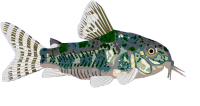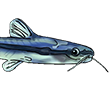a while back I stated that the juveniles of were easily recognized among other Ancistrus fry just based on their head shape (as adult ones are easily identified; a noteworthy exception in Ancistrus, I guess..).
While I don´t believe that a prove of my statement is really necessary, I still decided to finally document the present spawn of them (the first resulting in a significant count of fry; usually, dad would eat the spawns at latest on the second day and artificial hatching resulted in miserable 3 fry from 5 spawns up to now). The pictures are not up to Haarvards or Farids standards, but at least, the shape is recognizable, now that I abandoned the compact camera..
Right now, I have more than 50 fry from a single spawn in a rearing container, far more than I expected based on literature reports, and only lost 4 juveniles, before they started eating. This is also in contrast to available literature reports (well, I have one, actually, in the Wels Atlas 2), where it is stated that during the first weeks, fry are lost frequently when they start eating.
Well, let´s start with the pictures:
This is one of the fry when I took them from the males cave, five days after hatching. Just for proofing their head shape, this one actually already suffices, I guess, as already now the head is significantly bigger than I found in other Ancistrus species.
Six days after hatching, the yolk sack is still clearly visible, and the fry are characteristically coloured with their black/white striping. At this stage, the head (if the fish are sucked to something) is even wider than the remaining yolk.
With the eighth day, the yolk sack is almost completely gone and as the visible excretions show, their digestive apparatus is now fully functional. This is also the day I start feeding them.
They are fed a mixture of newly hatched brine shrimps and some fine granulate (thanks again for that, Jost!), also, there is always at least some leaf litter available, and occasionally, I feed the dried tips of stinging nettle (hope, that is the right word for “Brennnessel”).
At fourteen days, they have become quite active and it´s getting increasingly more difficult to get pictures where you can at least recognize the fish.. Yet, they are not as shy as their parents: Hypancistrus are real out goers and show-offs as compared to those scared bastards (consequently, I still didn´t manage to get a picture of the parents..).
The colouration of the adults starts to be visible with 18 days, with the little brownish dots (the green is due to the flash; the brown colouration of the pectoral fins and the bar at the caudal peduncle is more like it). Note also the comparably huge sucker mouth! Nothing close to the “standard bristlenose”. No wonder, the first oddballs imported were mistaken for Baryancistrus.
Their true colouration at the moment (this one is from today, 29 days; I finally found the time to take one out for closer examination) is more like in the picture above. The parent´s colouration is clearly visible, but the markings are all light brown and not green as in adult fish.
This brown colouration is also found in some of the imported fish, mostly in the smaller ones. Right now, I am following the hypothesis that the brown colouration is a kind of juvenile thing that turns into the typical green of adult fish upon maturation. At the moment, I cannot prove that, however. I intend to keep some of those fry for longer, to check on the development of their colouration. All keepers of this species I talked to until now stated that their brown fish turned green after some months; there aren´t any confirming (or contradicting) observations made by PCF-members, by chance..?
And to conclude today´s post, one to show the size: right now, almost exactly one month after hatching, they are 20 mm TL.
As time permits, I will, of course, continue to report on their development (unless no one´s interested).
Cheers, Sandor





/g/s/1.jpg)